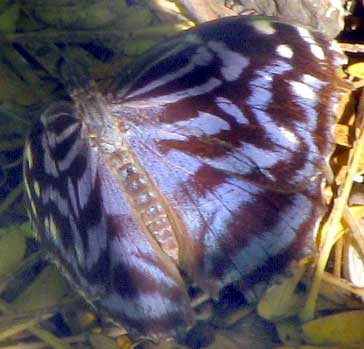Excerpts from Jim Conrad's
Naturalist Newsletter
from the January 17, 2010 Newsletter issued from Hacienda Chichen Resort beside Chichén Itzá Ruins, central Yucatán, MÉXICO; limestone bedrock, elevation ~39m (~128ft), ~N20.676°, ~W88.569°
BLUE IRIDESCENCE IN A SHAFT OF LIGHT
Early mornings this week were so chilly that I took long walks to keep warm, and sat in the rising sun when I could. One morning deep in the forest as I searched for a shaft of light to sit in a flash of iridescent blueness detonated on the forest floor where a little sun-fleck came and went as tree branches above shifted in the wind. In such chill gloom, "detonated" is the right word, for the color and brightness were shocking, simply stabbing into my consciousness.
I crept toward where the flash had come from, quietly parting undergrowth so as to frighten nothing away. At first the forest floor remained dark, but then a breeze shook a tree limb and again the flash exploded right below me, then growing dark again. The next time the sunfleck blinked on, my camera was focused on the spot, and that was fortunate, for exactly as I snapped the picture my quarry took wing. Below, you can see it, its wings slightly blurred with action.

Bea in Ontario figured out that it was a Mexican Bluewing, MYSCELIA ETHUSA, a tropical species distributed from Colombia through Central America and Mexico, periodically straying across the lower Rio Grande into extreme southern Texas. It's closely related to North America's Admiral Butterflies.
At the ButterfliesAndMoths.org website you can read about Mexican Bluewings -- for instance, that the adults eat rotting fruit and rest on tree trunks with their wings closed, exposing undersides that camouflage them as tree bark.
No amount of simple information, however, could offer anything like the pleasure of being introduced to the Mexican Bluewing as I was that morning.